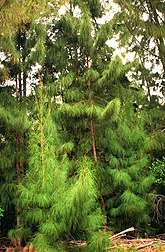Scientists Find Evidence of Casuarina Hybrids

(PhysOrg.com) -- Hybrids of the invasive Australian plant species Casuarina exist in Florida, Agricultural Research Service (ARS) scientists and university cooperators have found.
These fast-growing, pine-like trees were historically planted widely as ornamentals and along boulevards in south Florida, and are currently being proposed as a windbreak in citrus groves. However, the trees are frequently the tallest in the canopy and can be very damaging during storms and hurricanes. Casuarina has also become an environmental problem, invading and altering natural habitats including Everglades National Park, home to many threatened and endangered species.
Based on physical characteristics, scientists have long suspected hybridization among the three Casuarina species in Florida—C. glauca, C. cunninghamiana and C. equisetifolia—but it is difficult to verify hybridization by these characteristics alone.
DNA tests conducted by botanist John Gaskin, research leader of the ARS Pest Management Research Unit in Sidney, Mont., confirm the existence of hybrids. Examining the DNA, according to Gaskin, allows for better understanding of the identity of the plants and where they came from, and helps explain how these novel hybrids have become so invasive.
Gaskin collaborated with entomologist Greg Wheeler, with the ARS Invasive Plant Research Laboratory in Ft. Lauderdale, Fla.; Matt Purcell, director of ARS' Australian Biological Control Laboratory in Brisbane; and Gary Taylor, a research associate with the University of Adelaide. The team collected leaf samples from Casuarina species in Australia and Florida. Gaskin then used genetic markers to compare the collections and confirm which species and hybrids currently exist in Florida.
The researchers found that hybrid combinations of C. glauca and C. equisetifolia are present across a wide range of southern Florida. They also found C. glauca and C. cunninghamiana hybridization in one location.
The scientists did not, however, find evidence of hybrids in Australia. This could be problematic for biocontrol efforts, which rely heavily on co-evolution of biocontrol agents and target species to insure the highest rates of effectiveness. Potential biocontrols must now prove effective against parental species and hybrids.
The research was published in the scientific journal Molecular Ecology.
Provided by Agricultural Research Service




















